#the institute
Text
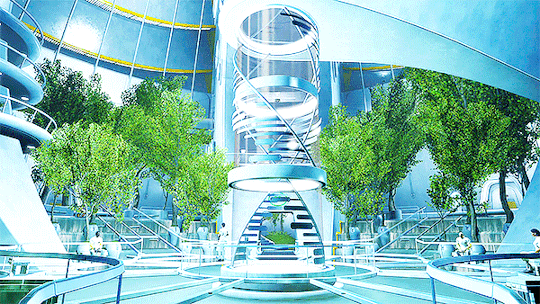

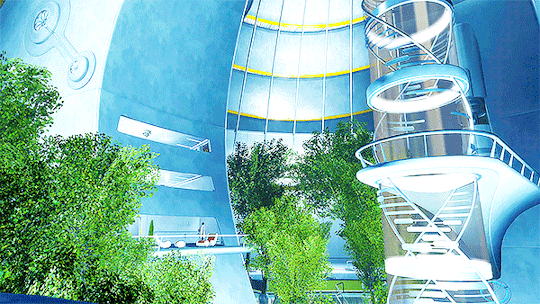
fallout 4 + scenery (5/?)
71 notes
·
View notes
Text

1K notes
·
View notes
Text

#i’m experimenting with the queue so i’m just posting whatever comes to mind to fill it up#fallout#fallout 4#fo4#arthur maxson#elder maxson#sole survivor#the sole survivor#brotherhood of steel#shaun fallout 4#shaun fo4#father fallout 4#father fo4#the institute#fallout memes#fallout 4 spoilers
389 notes
·
View notes
Text




This should clear up any moral debate, on destroying the Institute.
152 notes
·
View notes
Text

Happy Holidays from me and my favourite shady men (Deacon and X6)
Also reminding (for the 1000th time I’m sorry) my commissions are open!
#fallout 4#fallout#fallout 4 companions#fallout 4 fanart#deacon fallout#deacon#deacon fallout 4#x6 88#x6-88#deacon railroad#deacon fo4#fallout 4 x6#synth#courser#the railroad#the institute
175 notes
·
View notes
Text

I’m really enamored with @luubyart’s entire cast of characters, but Neo and the baby deathclaw duo stole my heart last year during Art Fight! Never trust a baby deathclaw in the teething stage with your boots
#My Art#Luubyart#Fallout OC#Fallout#Fallout 4#FO4#Deathclaw#Baby Deathclaw#The Institute#Luubyart: Neo#Art Fight#Your tags on my piece of Tiny encouraged me to share this haha#Thanks for enjoying my work <3
87 notes
·
View notes
Text

X6-88 appreciation doodle! He's so underrated
104 notes
·
View notes
Text

This Thing Called Defeat
Day 5 of Falloutober!!
Ty @falloutober for the prompts!
#feeling lukewarm about this one#it has good and it has bad so it’s just in the middle there#anyway tho I’m not gonna fret about it lol life is too short#fallout 4#sole survivor#father fallout 4#shaun fallout 4#the institute#fallout 4 fanart#fanart#fallout#fallout fanart#I used Damien’s colours but idk if I should actually tag this as him#fuck it yeah#Damien tag
87 notes
·
View notes
Text
I had this thought about Fallout 4 and the Institute a while back when my daughter (who is autistic and has a lot of issues with food) was really into this high-protein yogurt in pouches, but only one or two specific flavors that didn't have any bits in them. We dubbed it Space Yogurt (I was playing a lot of Starfield at the time and the pouches looked like the drink pouches in the game).
So in Fallout 4, the only food the Institute serves is this nutritionally complete food paste. My headcanon is that it's not because it's all they have or are capable of producing, but because synths (and a lot of the non-synth residents of the Institute) are very clearly autistically coded.
This choice of food has nothing to do with availability, IMO - it's about getting all these people with their various issues to actually consume enough nutrition in a day to keep them alive and functioning.
Food paste is textureless, easy to eat, doesn't require much attention or focus to consume, is probably not strongly flavored, and most importantly, it's consistent. Day after day, year after year, it's exactly the fucking same. Basically, it's ideal food for autistics, just like Space Yogurt.
Remember that one scientist who's complaining loudly that they've discontinued his favorite flavor of food paste? He's probably eaten this paste year in and year out, for as long as he can remember. Now it's gone, and he's having a meltdown because it was comforting and part of his routine and he fucking counted on it.
I don't have much sympathy for any of the Institute scientists, but I feel a little bad for Food Paste Guy, and for anyone who has to deal with him for the rest of that week.
#spark's headcanons#fallout 4#the institute#fallout headcanons#autistic headcanon#autistic food issues#institute food paste#headcanon#synths are autistic tho#actually autistic
34 notes
·
View notes
Text
Bethesda wanted to go personal with fallout 4, but then they didn't put in the time and thought that going personal requires!!
Where are the articulate, grown-up conversations (multiple conversations, not just one!) with adult Shaun about why he's made certain choices, let us talk about what he believes in!! Like, what he actually believes in. There's interesting arguments that could've been made in this scenario and they just never go there! (Arguments that go beyond the very surface level reasonings we hear from nearly every Institute NPC.) They could've done anything.
And while I'm here, actually reward the player for having a good relationship with Shaun. And when I say that I mean specifically the relationship with Shaun, not just your Institute standing. Let us bring him gifts (or some game mechanic that lets us raise his affinity without siding with the institute), in order to access more personal conversations. Why can't we have a deeper conversation with him about what it really would've been like if he hadn't been kidnapped. Would it have been shitty? Good? A mix of both? Plenty of opportunities for role playing here. Why can't we break down the barrier between our characters? Why isn't it a choice? If you don't care about Shaun you get Father, you get the cold figurehead who doesn't give a shit about anything but the Institute. But if you bother to talk to him, to find out how he feels? You can have something close to a parent/child relationship, you can find out how he actually feels about his life and what he's doing. Come on Bethesda, if you want it to be personal don't just rely on the players ability to imagine it being deeper than it is. I honestly think a lot of players aren't giving themselves credit for how much they themselves bring to the story with their own thoughts and ideas. If it was deep to you, then YOU brought that to the table.
My point here isn't just about Shaun either. Same goes for companions. For the love of god Bethesda, let your writers actually think about what they're writing. I know they can! We see glimpses of it all through the game, especially in far harbor. But whether it's a lack of time, or poor direction, or both, or something else.... idk. I don't mind games "going personal", but that cannot be shorthand for "we've given up".
#okay that's my bi annual fo4 rant ✌ see you in 6 months#fallout 4#mojave express announcement#the institute
382 notes
·
View notes
Text
Wasteland Survival Guide:
The Institute, Fusion Reactors, and M.I.T.'s Actual Basement
It's that time again. Periodically I make unreasonable longposts about Fallout-related topics (it's a good way to keep track of fic research). Today I'm tackling nuclear fusion, the Institute, and the real-world Massachusetts Institute of Technology's basement.
Yeah, Yeah, M.I.T. is the Institute, We've All Seen - Wait, What Do You Mean, "The Vault Laboratory?"
M.I.T. - the Massachusetts Institute of Technology - is a highly exclusive research university with a well-deserved reputation for hosting brilliant minds.
It also got its serial numbers filed off in order to host the in-game Institute. Why? Probably because of all the very real research into robotics, artificial intelligence, and power armor (no really). And because M.I.T. is actually doing now what the Institute tries to do in-game with nuclear fusion.
And, of course, because of the vaults in the basement.
You know what? I'll just start at the top...Read on below.
I'll be focusing on fusion-related research in this post, and comparing in-game Institute work on fusion to what's actually happening over at M.I.T. (We'll get to the Media Laboratory and robotics and AI and the, uhm, power armor stuff in a separate post. Or three.)
all actual M.I.T. researchers/faculty/students and/or nuclear physicists have my sincere apologies, I don't know shit about shit but I'm doing my best
I Didn't Sign Up for a Physics Class, but Okay
Here's the thing about nuclear fusion generators - y'know...the ones powering nearly** the entirety of pre-war in-game America?
Including self-contained, miniaturized reactors (fusion cores, fusion cells, microfusion cells, Corvega engines, assaultron and robobrain power supplies, recharger weapons, G.E.C.K.s, etc.) and full-scale reactors (powering vaults, the Lucky 38, the Prydwen (and Rivet City before Maxson Happened), missile silos, etc.)...?
We don't have them yet.
Of course we have nuclear power generation, what are you talking about?
Yes - but nuclear power plants currently operating use fission reactors! Fusion reactors, though? Well...

For the pre-war in-game universe, even more than for us, that fuel-to-energy ratio would have been absurdly important. Companies rushed to implement fusion for damn near every possible use, but waited until the Resource Wars left them no other choice. "No more (viable) oil reserves? Well, shit. Fusion it is."
Because of this, by October 23, 2077, pre-war Western markets were still somewhat new to adopting miniaturized nuclear fusion reactors.
For instance, Chryslus' first fusion vehicles - intentionally reminiscent of the absolutely wild Ford Nucleon concept car dreamed up in 1957 - came to market in 2070, less than a decade before the nuclear exchange.
As for the other benefits of nuclear fusion...Atom knows the in-game universe could do with less radioactive contamination:

It is no wonder the Institute wants to get the reactor in their basement up, running, and running better than originally designed.
Real-life M.I.T. is no stranger to running fusion reactors - they've been at it since the late '60s - but as it turns out, they are currently also "building a better mousetrap," and if they succeed they will be achieving all the Institute would hope for in clean energy production - without the moral deficit.
If nuclear fusion is so great, why aren't we using this technology yet IRL?
Because - and I cannot stress this enough - we are attempting to levitate bits of the Sun inside a donut to make really hot things boil water* so steam will turn a fan attached to a dynamo to power light bulbs.
*(there are two other ways to generate power using this heat)
Naturally...this comes with some complications.
We know fusion reactors can be the most energy-efficient form of power generation - we just need better reactors. That's where M.I.T. comes in.
The biggest problem right now is efficiency:
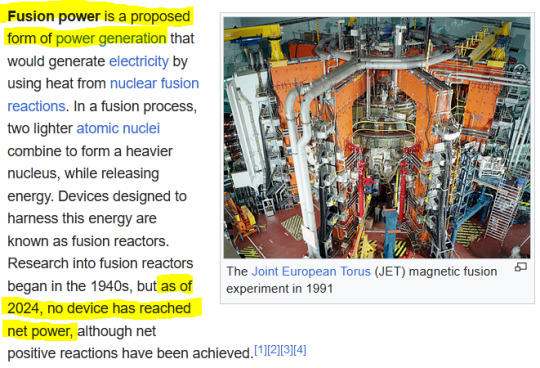
TL;DR - as of April 2024, all fusion reactors as a matter of course still consume more power to run than they are able to produce (meaning they do not reach "breakeven"). Many cutting-edge reactors also require tritium (very rare) as well as deuterium (very common) fuel.
We did not even see a fusion reaction that reached "breakeven" for power production until December of 2022. That reaction occurred at the National Ignition Facility in California, and their results just passed peer review in February of this year (2024).
Several in-progress reactors aim to improve on this, including ITER (the combined work of dozens of nations) in France, and SPARC: the new reactor under development by Mass Fusion Commonwealth Fusion Systems and M.I.T.'s Plasma Science and Fusion Center (PSFC).
Another big problem with this technology is that it involves plasma.
Plasma, as a particular song reminds us, is what the Sun is made of and The Sun Is Hot. That means plasma carries some very real 'we're-losing-structural-integrity, the-warp-core-is-breaching' risks, and we must jump through all kinds of hoops to work with it.
Why are we shoving the Sun inside a donut, again?
The most well-funded, well-researched way of smashing atoms together involves plasma and magnetic confinement fusion.
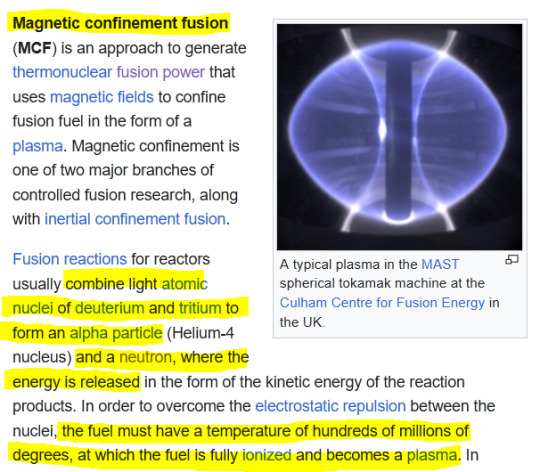
This shit is beyond cool. It may also look very familiar:
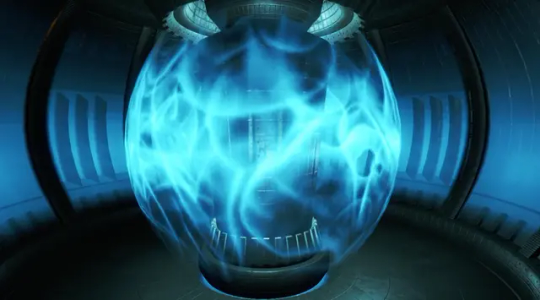
In-game, the Institute is trying to get what appears to be a spherical tokamak reactor up and running.
Bethesda's choice of reactor was no coincidence: M.I.T. operated the Alcator C-Mod, a spherical tokamak, while Fallout 4 was under development - but that reactor could not achieve "breakeven" IRL, and per Shaun's in-game dialogue, the fictional Alcator C-Mod couldn't either. (Weird given the miniaturized fusion devices everywhere in-universe, but okay, Shaun.)
However, M.I.T. stopped operating that reactor in 2016, a year after Fallout 4's release. SPARC, their planned replacement reactor actually has the sort of power potential we see in-game - and they aim to bring fusion power to market in this decade.
M.I.T., right now, in real life, is doing exactly what you're asked to help the Institute do in-game: build a fusion reactor that surpasses "breakeven."
What the hell is a tokamak and why does it look like half of a Star Trek warp core?
Your typical tokamak reactor is a great big donut-shaped vacuum chamber (the torus), traditionally surrounded by AT LEAST three sets of electromagnets (sometimes many more). M.I.T.'s design for the new SPARC reactor is a bit different, but let's start with the basics.
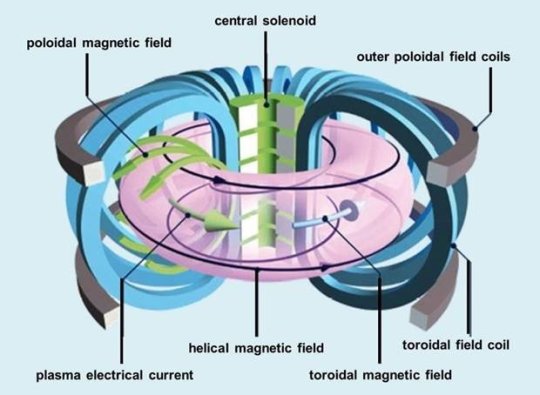
Why so many magnets?
Because plasma, being Literal Sun Matter, cannot come into contact with the torus containment walls or it will instantly burn through. (This happened in France in 1975. Following initial "well, fuck"s and a couple years' repairs, the logical next step was to publish a paper about it.)
The magnetic fields work to heat the plasma and provide current drive (keep electrons moving in a consistent direction through the plasma and around the torus), while also keeping it from touching anything, preventing a "warp core breach." I'll take a stab at explaining it but the Department of Energy probably does it better.
Meet the magnets:
Toroidal field magnets (blue, above): These enormous D-shaped magnets wrap around and through the torus, conducting an electrical current. This creates a magnetic field that keeps plasma from drifting horizontally into the containment walls.
Central solenoid (green, above): Inside the "donut hole" sits a massive, stacked electromagnet that generates enough electromagnetic force to launch two space shuttles at once. This heats the fuel to about one hundred million degrees Celsius so that it reaches plasma state, and helps "drive" the plasma current around the torus. (Radiofrequency or neutral beam injection heating/drive may be used as well for reactor prototypes aiming for power generation, because current drive from just the solenoid isn’t practical for continuous operation.) The central solenoid also creates another magnetic field called the "poloidal field," which "loops" around the plasma like a collar to prevent it from drifting vertically into the walls. The strongest central solenoid in existence was made for the ITER reactor...by General Atomics.
Outer poloidal field magnets (grey, above): A third set of electromagnets "stacks" up the outside of the torus, and helps maintain and adjust the poloidal field.
Together these three sets of magnets force the plasma to "float" inside the torus, shape it, and provide current drive. The stronger the magnetic field, the higher the reactor's power output.
Okay, and then what?
Given sufficient heat and drive/stability, the plasma fuel mixture undergoes fusion.
Neutrons released during fusion have plenty of kinetic energy (the kind of energy a kickball has midair before it hits you in the face), but no electric charge.
Since magnetic fields only affect negatively or positively charged particles, neutrons completely ignore the fields, sailing straight through and slamming into a "blanket" of metal coating the donut's insides. Neutrons passing into the 'blanket" lose their kinetic energy, which is converted to heat and absorbed by the "blanket." (ITER's "blanket" involves a lot of beryllium, which...behaves a bit differently IRL than it does in-game.)
Heat captured by the "blanket" is then used to generate power. For instance, a water cooling system can bleed heat from the "blanket," regulating temperature and creating superheated highly-pressurized steam to run turbine generators.
I notice you described a "typical" tokamak above -what's the atypical option?
Check out SPARC.
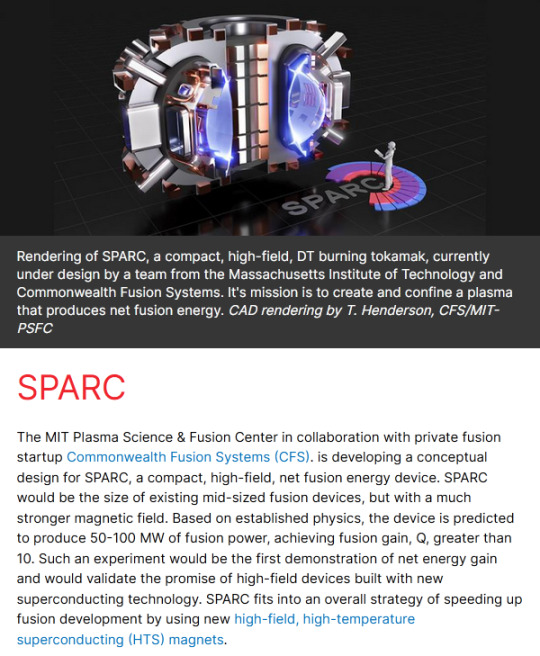
Its huge design departure is that it uses new high-temperature superconducing magnets (most existing types have to be cooled to vacuum-of-space temperatures using something like a liquid helium system to achieve superconductivity, which is a huge power drain) to create a monstrous magnetic field - and its size is tiny in comparison to its projected power output.
Neat. So why did you refer to plasma as a problem?
Well...between the heat and the neutrons, the "blanket," the "first wall" and all plasma-facing surfaces inside the torus take one hell of a beating:

"Neutron degradation of wall surfaces-" "Energy is released in the form of the kinetic energy of the reaction products-" In practical terms, that just means countless neutrons are doing THIS:

...but to the containment wall and other surfaces inside the torus, instead of to Batshuayi's face. And so:

Basically, this stuff breaks fast enough - and the only materials that don't break quickly are rare enough - to create a real barrier to commercial use.
And THIS is one of the problems they're working on solving in M.I.T.'s basement.
Now we can talk about the Vault. FINALLY.
M.I.T. is home to the Center for Science and Technology with Accelerators and Radiation (CSTAR). CSTAR's splash page announces:
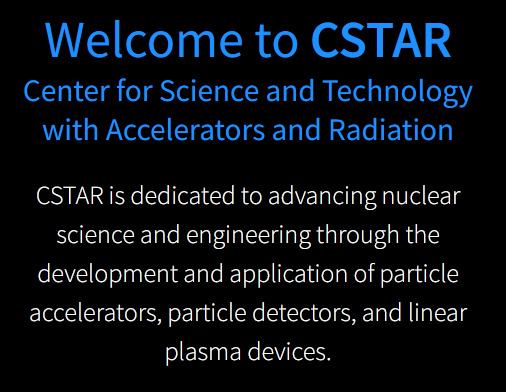
Linear plasma devices? You mean like -
No, not like plasma rifles. Instead of weapons, we're talking about tools being used to solve the "plasma fucking destroys everything it touches" problem.
How does CSTAR do this? They've got CLASS. ...No, really:

This field is called plasma-surface interaction science, and if you want a really long but very informative read on how CSTAR's work helps move it forward, check this out. It involves the DIONISOS Linear Plasma Device - a "let's shoot it with plasma and see what happens" tool.
CSTAR also works to better undertstand how materials handle radiation damage, and how they behave after becoming irradiated.
And to handle this sort of work, one needs a...

The Vault Laboratory for Nuclear Science "combines high-intensity particle sources, precision particle detection, and a heavily shielded experimental area to create a facility for nuclear research in high-radiation environments." It contains, among other things:
the DT Neutron Generator, which is used in a variety of experiments, including radiation detector development (pretty damned important) and characterization, fast neutron imaging, and material activation (stuff becoming radioactive).
the DANTE Tandem Accelerator, which was "originally designed to produce high neutron yields for use in cancer therapy research."
And that is what's actually going on in M.I.T.'s basement: truth is cooler than fiction.
The takeaways:
Yes, M.I.T. really is building a revolutionary fusion reactor with parts from Mass Fusion Commonwealth Fusion Systems.
Yes, there really is a secure underground facility where incredibly advanced research related to nuclear fusion, radiation detection, irradiated materials, and degradation of materials due to radiation exposure takes place.
Yes, I really would spend eight hours researching nuclear physics instead of doing more dishes. Shoutout to @twosides--samecoin for tolerating my absurd hyperfocus on researching this.
Thanks for coming to my TED talk on what M.I.T. is really doing in its basement.
Tune in next time for M.I.T.'s Media Laboratory, and how it is related to real-world power armor, plus: the relationship between Langley, P.A.M.'s IRL cousin, and Vault 101.
** (Fallout is wildly inconsistent re: how widespread fusion is in-game and when it was developed. I mean we're talking a two-decade spread of inconsistency! And somehow the technology - first available to the military - was then miniaturized and made available to the general public before becoming widespread for commercial power generation? And somehow we both do and don't have impossible cold fusion in game? It's a mess. I reject this reality and replace it with a fish, hence this post.
Also, I hate fission batteries. don't talk to me about fission batteries, "fission batteries" are small fission reactors but they are definitely not "battery sized" - the "fission batteries" in-universe are so miniaturized that they are more likely another kind of atomic battery like a radioisotope thermoelectric generator and those are subject to a law of diminishing returns as the fuel decays/not producing a reasonably useful power output after over 200 years due to the isotopes normally used/can be VERY dangerous if the shielding is breached or removed, and - you know what, that's also a whole different post.)
#actual insanity#fallout#fallout 4#why am I like this#nuclear fusion#physics#institute#fallout institute#the institute#worldbuilding#meta#oneifbyland#wasteland survival guide
25 notes
·
View notes
Text



fallout 4 + scenery (4/?)
47 notes
·
View notes
Text

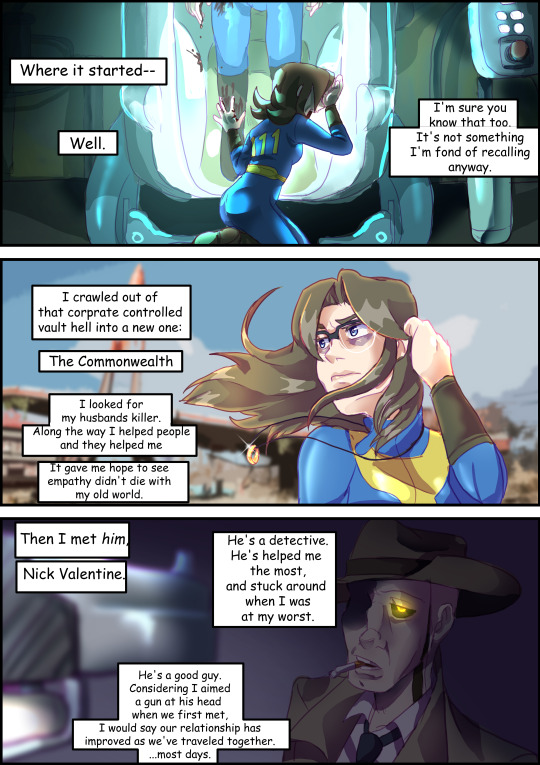
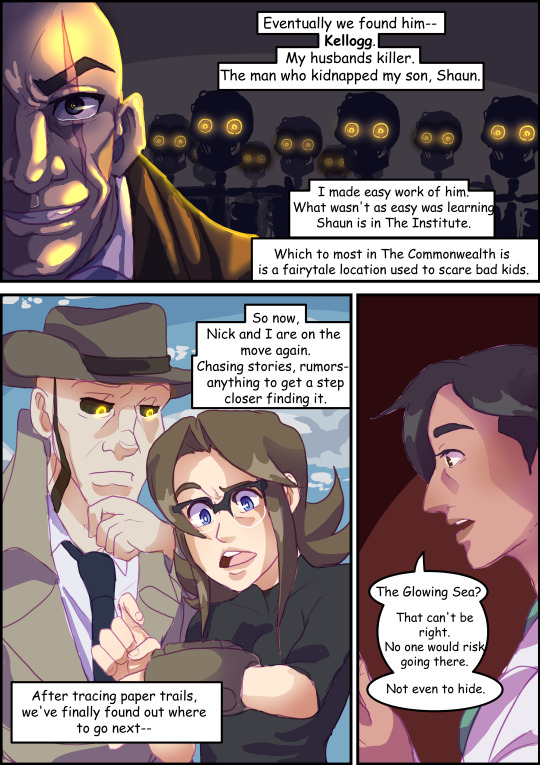


Next
Previous
First
#fallout#fallout 4#fo4#fo4 comic#fallout 4 comic#dependent#kellar curtis#nick valentine#kellogg#conrad kellogg#the institute#dr amari#sole survivor#sosu#fallout oc#the memory den#good neighbor
153 notes
·
View notes
Text
*X6-88 voice* He’s an 😏 earlier model
#look he’s not a courser anymore so he needs to be better than the other synths SOMEhow#yes this is about danse#idk i just want them to annoy each other it would be neat#fallout#fallout 4#fo4#x6 88#x6-88#fallout x6 88#danse#paladin danse#danse fallout 4#the institute#danse fallout#x6-88 fallout 4
46 notes
·
View notes
Text


Showcase of the Daisy Synths' eye colors and variations. The Combat and Research models have dedicated combat modes that are automatically triggered when a threat is perceived, as indicated by the change in eye color. This was originally intended as an easy way to track and record the units' responses to stimuli during testing
Combat models include the A, B, and C series. Research models are exclusively the F series
The Enhanced Coursers and Zenith are not experimental models like the others and thus have static eye colors
#the D and E series are outliers; D being infiltration models with fully changeable eyes and E being a mishmash of other models#but all the eyes also flash when receiving data. yk. like a usb stick#fallout 4#fo4#fallout synth#the institute#timeline: the daisy experiments#drawing4nuclearwinter#id in alt#i swear i'll post the actual lore for the daisy synths at some point
21 notes
·
View notes
Text
Fallout 4: Synth Fabrication Room

Pictured: Concept art for the Synth Fabrication Room in Fallout 4, depicting the process of how Synths are created.
This artwork was created by Ilya Nazarov, one of four concept artists who worked on Fallout 4.
You can read more about Synths and the Institute here:
https://fallout.wiki/wiki/Synth
https://fallout.wiki/wiki/The_Institute
#fallout wiki#independent fallout wiki#fallout 4#fallout synth#synth#fallout#fallout series#the institute
91 notes
·
View notes